Related Research Articles
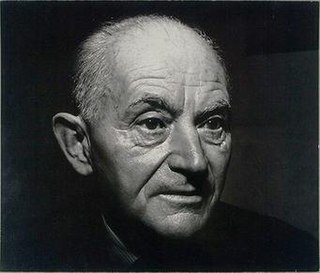
Daniel-Henry Kahnweiler was a German-born art collector, and one of the most notable French art dealers of the 20th century. He became prominent as an art gallery owner in Paris beginning in 1907 and was among the first champions of Pablo Picasso, Georges Braque and the Cubist movement in art.

The Museo Nacional Centro de Arte Reina Sofía is Spain's national museum of 20th-century art. The museum was officially inaugurated on September 10, 1992, and is named for Queen Sofía. It is located in Madrid, near the Atocha train and metro stations, at the southern end of the so-called Golden Triangle of Art.
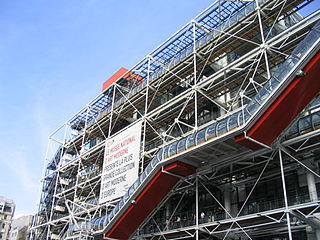
The Musée National d'Art Moderne is the national museum for modern art of France. It is located in Paris and is housed in the Centre Pompidou in the 4th arrondissement of the city. In 2021 it ranked 10th in the list of most visited art museums in the world, with 1,501,040 visitors. It is one of the largest museums for modern and contemporary art.

Guernica is a large 1937 oil painting by Spanish artist Pablo Picasso. It is one of his best-known works, regarded by many art critics as the most moving and powerful anti-war painting in history. It is exhibited in the Museo Reina Sofía in Madrid.

Ambroise Vollard was a French art dealer who is regarded as one of the most important dealers in French contemporary art at the beginning of the twentieth century. He is credited with providing exposure and emotional support to numerous then-unknown artists, including Paul Cézanne, Aristide Maillol, Pierre-Auguste Renoir, Louis Valtat, Pablo Picasso, André Derain, Georges Rouault, Paul Gauguin, and Vincent van Gogh.
Sidney Janis was a wealthy clothing manufacturer and art collector who opened an art gallery in New York in 1948. His gallery quickly gained prominence, for he not only exhibited work by the Abstract Expressionists, but also European artists such as Pierre Bonnard, Paul Klee, Joan Miró, and Piet Mondrian. As the critic Clement Greenberg explained in a 1958 tribute to Janis, the dealer's exhibition practices had helped to establish the legitimacy of the Americans, for his policy "not only implied, it declared, that Jackson Pollock, Willem de Kooning, Franz Kline, Phillip Guston, Mark Rothko, and Robert Motherwell were to be judged by the same standards as Matisse and Picasso, without condescension, without making allowances." Greenberg observed that in the late 1940s "the real issue was whether ambitious artists could live in this country by what they did ambitiously. Sidney Janis helped as much as anyone to see that it was decided affirmatively."
Mourlot Studios was a commercial print shop founded in 1852 by the Mourlot family and located in Paris, France. It was also known as Imprimerie Mourlot, Mourlot Freres and Atelier Mourlot. Founded by Francois Mourlot, it started off producing wallpaper. Later, his son Jules Mourlot would expand the business to handle the production of chocolate labels for companies such as Chocolat Poulain, as well as ledgers, maps and stationery. Starting in the 1920s, Jules' son, Fernand Mourlot, converted one of the locations into a studio dedicated to printing fine art lithography.

The Galeria Mayoral was launched in Barcelona, Spain in 1989. The gallery has two types of exhibitions: collective shows based on a specific theme and solo exhibitions of the work of artists that are especially relevant to the history of twentieth-century and early twenty-first century.
Klaus Gunther Perls (1912–2008) was born in Berlin, Germany, where his parents were art dealers. He studied art history in Munich, but after the Nazis stopped granting degrees to Jews he moved to Basel, Switzerland and completed his studies. Here, he wrote a dissertation on the 15th-century French painter Jean Fouquet.

Acquavella Galleries is an art gallery located at 18 East 79th Street between Madison and Fifth Avenues in the Upper East Side neighborhood of Manhattan, New York City.
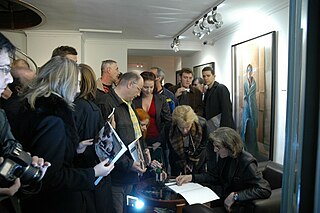
István Sándorfi was a Hungarian hyperrealist painter.
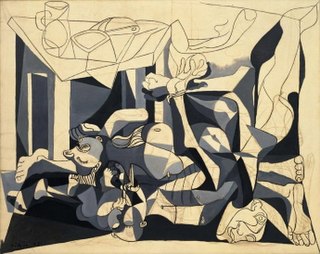
The Charnel House is an unfinished 1944–1945 oil and charcoal on canvas painting by Spanish artist Pablo Picasso, which is purported to deal with the Nazi genocide of the Holocaust. The black and white 'grisaille' composition centres on a massed pile of corpses and was based primarily upon film and photographs of a slaughtered family during the Spanish Civil War. It is considered to be the second of three major anti-war Picassos, preceded by Guernica in 1937 and succeeded by Massacre in Korea in 1951. The painting is housed in the Museum of Modern Art in New York City.

Yvette Cauquil-Prince was a Belgian-born weaver and master craftswoman who created tapestries in direct collaboration with renowned 20th-century artists and/or their estates. She is best known for her association with the artist Marc Chagall, which resulted in over 40 tapestries, but she also created tapestries of art works by Pablo Picasso, Max Ernst, Roberto Matta, Paul Klee, Fernand Léger, Pierre Wemaëre, Wassily Kandinsky, Brassai, Alexander Calder, Niki de Saint Phalle, and others.

Berthe Weill was a French art dealer who played a vital role in the creation of the market for twentieth-century art with the manifestation of the Parisian Avant-Garde. Although she is much less known than her well-established competitors like Ambroise Vollard, Daniel-Henry Kahnweiler and Paul Rosenberg, she may be credited with producing the first sales in Paris for Pablo Picasso and Henri Matisse and with providing Amedeo Modigliani with the only solo exhibition in his lifetime.

Marie Cuttoli was a French entrepreneur, born in Tulle, and patron of modernist tapestry.
The Art for Amnesty-Sís-Atelier Pinton Tapestries are an ongoing collection of giant memorial tapestries designed by artist Peter Sís and created by French tapestry manufacturer Ateliers Pinton for Art for Amnesty, Amnesty International's global artist engagement program.

Theodor "Teto" Ahrenberg was a Swedish businessman and collector. His extensive collection featured works by artists such as Pablo Picasso, Henri Matisse, Marc Chagall, Le Corbusier, Olle Bærtling, Sam Francis, Mark Tobey, Christo, Lucio Fontana, Tadeusz Kantor, Enrico Baj, Jean Tinguely, and Niki de Saint Phalle. Key works in the collection included the two versions of Matisse's Apollo (1953), Picasso's Nude in a rocking chair (1956) and Chagall's Les mariés sous le baldaquin (1949).
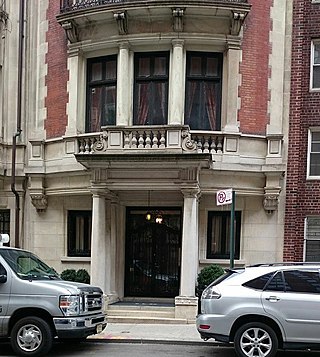
Galerie Chalette was a private contemporary art gallery in Manhattan, New York, USA. It was founded by the married art dealers and collectors Madeleine Chalette Lejwa (1915–1996) and Arthur Lejwa (1895–1972) in February 1954. The Lejwas were refugees from the Nazi invasions of Poland and France. Initially, their gallery specialized in contemporary French and Polish prints and painting. Later they changed its focus to contemporary 20th century American and European Sculpture, and especially the work of Jean Arp.
Jacqueline de la Baume Dürrbach is a French textile artist. She is best known for having co-created the tapestry of Pablo Picasso's Guernica that has hung at the United Nations since 1985.
Siegfried Rosengart was a German-Swiss art dealer.
References
- ↑ Ramié, A. (1988). Picasso: Catalogue of the edited ceramic works: 1947-1971. Vallauris: Galerie Madoura. Jane Kahan Gallery cited under Exhibition Credits
- ↑ "PICASSO | JANE KAHAN | Picasso Chagall Miro Leger Calder | Tapestry Ceramics". December 30, 2010.
- ↑ Baal-Teshuva, Jacob. Tapisserien: Hommage an Die Meisterweberin Yvette Cauquil-Prince Und Sammlung Jane Kahan, N.Y., Tapisserien Aus Dem Atelier Pinton, Aubusson: KunstHausWien, 10. Februar-14. Mai 2000. Museums Betriebs Gesellschaft, 2000.
- ↑ Hedlund, Ann Lane, "Tapestry Translations in the Twentieth Century: The Entwined Roles of Artists, Weavers, and Editeurs" (2004). Textile Society of America Symposium Proceedings. p. 308. https://digitalcommons.unl.edu/tsaconf/462
- ↑ Gilbert, Ruth, editor. “In and Around Town: Art.” NEW YORK MAGAZINE, 12 Nov. 1973, pp. 36–38. Google Books Link
- ↑ “THE PCN DIRECTORY.” The Print Collector's Newsletter, vol. 5, no. 6, 1975, p. 163. JSTOR, https://jstor.org/stable/44129858
- ↑ HANDMADE PAPER: PRINTS AND UNIQUE WORKS, Organized by Richard Marshall, The Museum of Modern Art, New York. June 28 – Sept 12, 1976. See master checklist for artwork credit lines thanking Kahan Esikoff Fine Arts. https://www.moma.org/documents/moma_master-checklist_327001.pdf
- ↑ "IFPDA - Dealer". www.ifpda.org.
- ↑ File:Dr. Alain Marty--Yvette Cauquil-Prince--Jane Kahan--Meret Meyer-Graber--Sarrebourg 2005.jpg
- ↑ "Leger Tapestry and Tapestries | AubussonTapestry.com". www.aubussontapestry.com.
- ↑ Wood, G. (2007). Surreal things: Surrealism and design. London: V & A Publications. Jane Kahan Gallery cited under Object Credits
- ↑ "Maison Pinton 1867 - Pinton".
- ↑ "GFR Tapestry Program » What? Where is the GFR Tapestry Program?".
- ↑ "Guernica Tapestry, San Antonio". Texas Monthly. July 1, 2012.
- ↑ Gladstone, Rick (February 27, 2021). "'Guernica' Tapestry Is Taken Back From U.N. by a Rockefeller". The New York Times. ISSN 0362-4331 . Retrieved March 26, 2021.
- ↑ Gladstone, Rick (February 5, 2022). "'Guernica' Antiwar Tapestry Is Rehung at U.N." The New York Times. ISSN 0362-4331 . Retrieved March 13, 2022.